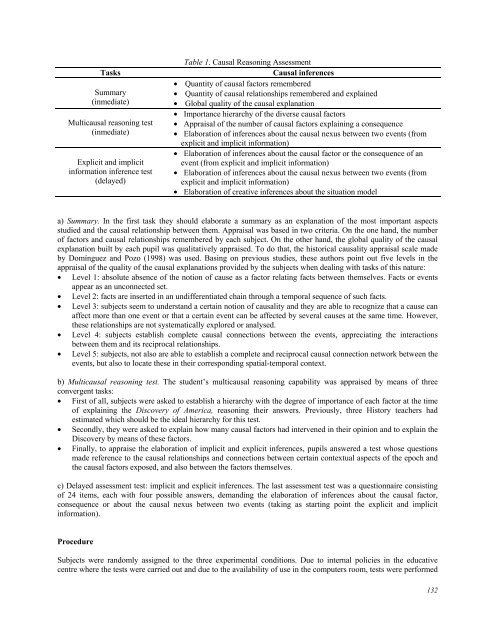Hypergraphics for history teaching - Educational Technology & Society
Hypergraphics for history teaching - Educational Technology & Society
Hypergraphics for history teaching - Educational Technology & Society
Create successful ePaper yourself
Turn your PDF publications into a flip-book with our unique Google optimized e-Paper software.
Table 1. Causal Reasoning Assessment<br />
Tasks Causal inferences<br />
• Quantity of causal factors remembered<br />
Summary<br />
• Quantity of causal relationships remembered and explained<br />
(inmediate)<br />
• Global quality of the causal explanation<br />
• Importance hierarchy of the diverse causal factors<br />
Multicausal reasoning test • Appraisal of the number of causal factors explaining a consequence<br />
(inmediate)<br />
• Elaboration of inferences about the causal nexus between two events (from<br />
explicit and implicit in<strong>for</strong>mation)<br />
• Elaboration of inferences about the causal factor or the consequence of an<br />
Explicit and implicit event (from explicit and implicit in<strong>for</strong>mation)<br />
in<strong>for</strong>mation inference test • Elaboration of inferences about the causal nexus between two events (from<br />
(delayed)<br />
explicit and implicit in<strong>for</strong>mation)<br />
• Elaboration of creative inferences about the situation model<br />
a) Summary. In the first task they should elaborate a summary as an explanation of the most important aspects<br />
studied and the causal relationship between them. Appraisal was based in two criteria. On the one hand, the number<br />
of factors and causal relationships remembered by each subject. On the other hand, the global quality of the causal<br />
explanation built by each pupil was qualitatively appraised. To do that, the historical causality appraisal scale made<br />
by Domínguez and Pozo (1998) was used. Basing on previous studies, these authors point out five levels in the<br />
appraisal of the quality of the causal explanations provided by the subjects when dealing with tasks of this nature:<br />
• Level 1: absolute absence of the notion of cause as a factor relating facts between themselves. Facts or events<br />
appear as an unconnected set.<br />
• Level 2: facts are inserted in an undifferentiated chain through a temporal sequence of such facts.<br />
• Level 3: subjects seem to understand a certain notion of causality and they are able to recognize that a cause can<br />
affect more than one event or that a certain event can be affected by several causes at the same time. However,<br />
these relationships are not systematically explored or analysed.<br />
• Level 4: subjects establish complete causal connections between the events, appreciating the interactions<br />
between them and its reciprocal relationships.<br />
• Level 5: subjects, not also are able to establish a complete and reciprocal causal connection network between the<br />
events, but also to locate these in their corresponding spatial-temporal context.<br />
b) Multicausal reasoning test. The student’s multicausal reasoning capability was appraised by means of three<br />
convergent tasks:<br />
• First of all, subjects were asked to establish a hierarchy with the degree of importance of each factor at the time<br />
of explaining the Discovery of America, reasoning their answers. Previously, three History teachers had<br />
estimated which should be the ideal hierarchy <strong>for</strong> this test.<br />
• Secondly, they were asked to explain how many causal factors had intervened in their opinion and to explain the<br />
Discovery by means of these factors.<br />
• Finally, to appraise the elaboration of implicit and explicit inferences, pupils answered a test whose questions<br />
made reference to the causal relationships and connections between certain contextual aspects of the epoch and<br />
the causal factors exposed, and also between the factors themselves.<br />
c) Delayed assessment test: implicit and explicit inferences. The last assessment test was a questionnaire consisting<br />
of 24 items, each with four possible answers, demanding the elaboration of inferences about the causal factor,<br />
consequence or about the causal nexus between two events (taking as starting point the explicit and implicit<br />
in<strong>for</strong>mation).<br />
Procedure<br />
Subjects were randomly assigned to the three experimental conditions. Due to internal policies in the educative<br />
centre where the tests were carried out and due to the availability of use in the computers room, tests were per<strong>for</strong>med<br />
132
















